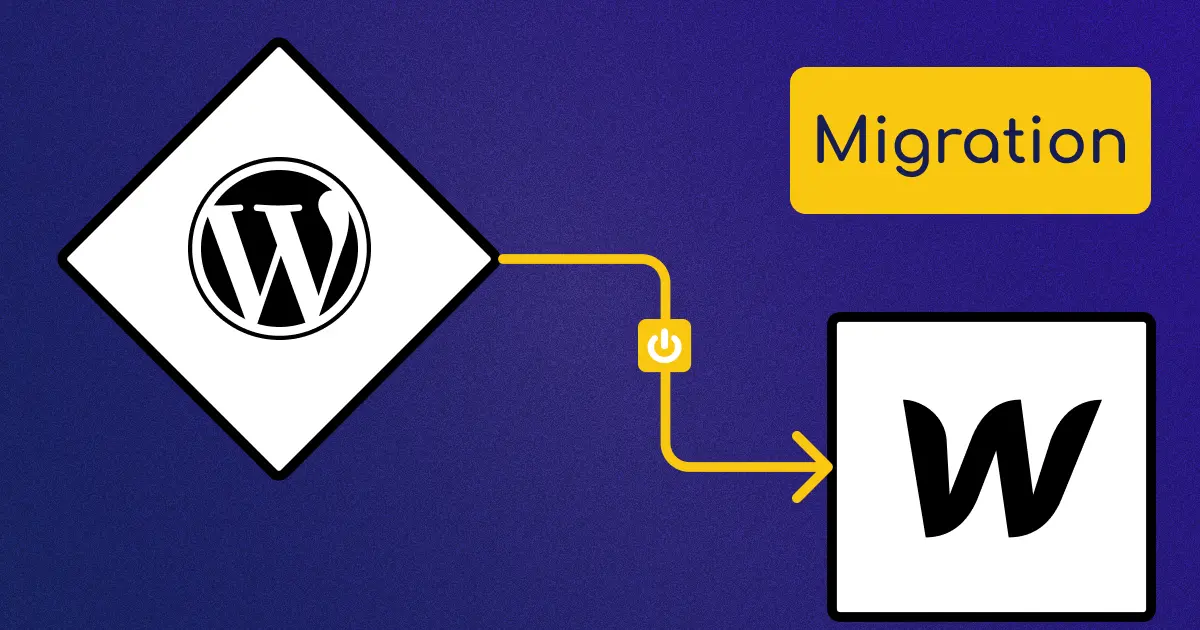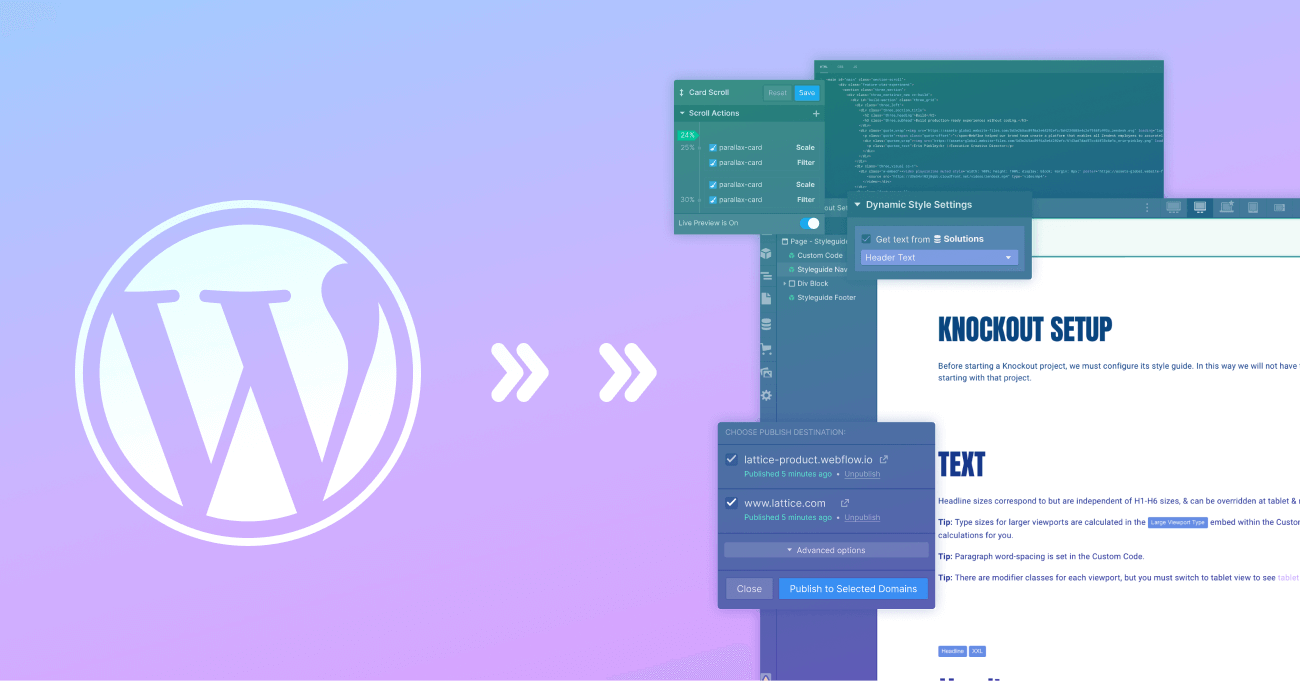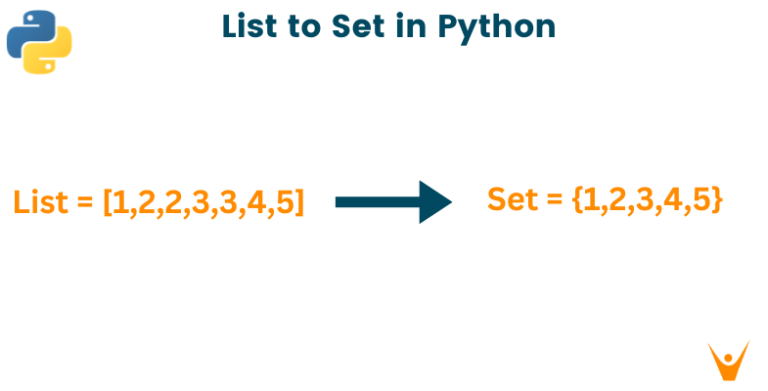WordPress to Webflow: A Seamless Migration Guide for 2024 (and Beyond!)
WordPress reigns supreme as the go-to platform for millions of websites. However, for design-focused individuals and businesses seeking more creative control, Webflow’s visual appeal and development flexibility are becoming increasingly attractive. If you’re considering migrating from WordPress to Webflow, you’re not alone. This comprehensive guide will equip you with the knowledge and strategies for a smooth and successful transition.
What is WordPress to Webflow?
WordPress to Webflow refers to the process of migrating a website from WordPress, a popular Content Management System (CMS), to Webflow, a design-centric website builder.
Transitioning to Webflow unlocks a multitude of advantages:
- Enhanced Design Control: Unleash your creativity and craft a website that perfectly embodies your brand identity. Webflow’s visual design capabilities empower you to go beyond the limitations of pre-built themes.
- Improved User Experience: Create a website that not only looks stunning but also delivers an intuitive and engaging user experience for your visitors.
- Faster Loading Times: Webflow’s clean code promotes optimal website performance, resulting in faster loading times and a smoother user journey.
- Content Management Flexibility: While the initial learning curve might be slightly steeper, Webflow’s built-in content management system allows you to manage your website’s content with ease.
- Potential SEO Benefits: A well-structured Webflow website with proper implementation of 301 redirects can potentially improve your SEO ranking in search results.
Understanding the Differences
While both WordPress and Webflow empower you to create and manage websites, their core functionalities differ. WordPress thrives as a Content Management System (CMS). Its user-friendly interface and vast ecosystem of themes and plugins make it ideal for content-driven websites. Webflow, on the other hand, shines as a design-centric website builder. Imagine it as a powerful visual editor that grants pixel-perfect control over every aspect of your website’s design.
Here’s a breakdown of some key differences:
- Design Flexibility: Webflow allows for complete design freedom. Drag, drop, and visually craft every element, surpassing the limitations of pre-built WordPress themes.
- Content Management: WordPress offers a familiar post and page editing experience. Webflow utilizes a content management system within its interface, allowing for structured content organization.
- Scalability: WordPress excels at managing large amounts of content, making it ideal for blogs and news websites. Webflow caters well to design-heavy websites and can scale to handle complex layouts, but the learning curve for content management might be steeper for some users.
Planning Your WordPress to Webflow Migration
A successful migration hinges on a well-defined plan. Here are some crucial steps to consider before diving into the process:
1. Define Your Goals:
What are your primary motivations for migrating to Webflow? Is it a desire for a more visually stunning website that reflects your unique brand identity? Do you crave greater design control to create a user experience that sets you apart? Identifying your objectives will guide your migration strategy and help you determine if Webflow is the right fit for your needs.
2. Inventory Your Content:
Take a comprehensive inventory of all your website’s content. This includes pages, posts, images, videos, downloadable files, and any other content elements that need to be migrated. Creating a detailed list will streamline the migration process and ensure you don’t miss anything crucial.
3. Evaluate Third-Party Integrations:
Do you currently rely on WordPress plugins for specific functionalities on your website? Research whether Webflow offers native solutions for these functionalities or explore alternative solutions that can be integrated seamlessly with Webflow. This ensures a smooth transition and minimizes disruption to your website’s core operations.
4. Consider SEO Impact:
Search Engine Optimization (SEO) is vital for maintaining your online visibility. Discuss strategies with a developer or SEO specialist to minimize potential ranking disruptions during migration. This might involve planning for proper 301 redirects (which forward visitors from your old WordPress URLs to the corresponding pages on your new Webflow website) and ensuring your website’s metadata (titles, descriptions) is properly transferred.
By carefully considering these steps upfront, you can lay the groundwork for a smooth and successful WordPress to Webflow migration.
Executing Your WordPress to Webflow Migration
The method you choose to migrate your content from WordPress to Webflow depends on the complexity of your website and your technical expertise. Here’s a breakdown of the three main options:
1. Manual Migration (Best for Small Websites)
This method involves manually recreating each page and post within Webflow. It’s suitable for websites with a limited amount of content, such as simple portfolios or landing pages. However, for larger websites with numerous pages and posts, a manual migration can be extremely time-consuming and prone to errors.
2. Plugin-Assisted Migration (Recommended for Most Cases)
This is the recommended approach for most websites. Popular plugins like “Webflow – WordPress Importer” or “δέfi: Migrate to Webflow” streamline the migration process. These plugins allow you to export your content from WordPress in a format compatible with Webflow, and then import it into your new Webflow website. This method saves you significant time and effort compared to a manual migration.
3. Developer-Led Migration (Complex Sites)
For intricate websites with extensive customization, unique functionalities, or a large amount of complex content, consider hiring a Webflow developer to create a custom migration solution. A developer can handle intricate tasks like migrating custom code snippets, integrating third-party applications, and ensuring a seamless transition for complex functionalities.
Choosing the Right Migration Method
The best migration method depends on your website’s complexity and your comfort level with technical tasks. If you have a small website and are comfortable with basic technical aspects, a manual migration might be feasible. However, for most websites, a plugin-assisted migration offers the best balance of efficiency and ease of use. If your website is highly complex or has unique technical requirements, consider collaborating with a Webflow developer to ensure a smooth and successful migration.
Optimizing Your Webflow Website (Post-Migration)
The migration is just the beginning! Here’s how to ensure a smooth user experience and optimal performance on your new Webflow website:
- Update Navigation: Double-check all links and menus to ensure they function correctly and direct users to the intended pages on your Webflow site.
- Redirect Old URLs (using 301 redirects): Preserve your SEO value by redirecting users from their old WordPress URLs to the corresponding pages on your new Webflow website. This ensures search engines continue to recognize your website and its content.
- Test Thoroughly: Before launching your new website, rigorously test all functionalities, forms, and user interactions to guarantee a flawless user experience.
Conclusion
Migrating from WordPress to Webflow can be a strategic decision that elevates your website’s design and functionality. By carefully planning your migration, choosing the appropriate method, and optimizing your Webflow website afterwards, you can ensure a smooth transition and unlock the full potential of Webflow’s design capabilities. Keep in mind that the ideal platform for your website varies according to your individual requirements and objectives. Carefully consider the advantages and disadvantages to arrive at a well-informed choice.
Ready to Streamline Your Website Management and Unleash Stunning Design? At OnextDigital, our team of Webflow experts can guide you through every step of the WordPress to Webflow migration process. We offer a range of services to ensure a seamless transition and empower you to leverage Webflow’s capabilities: Web Development Service, Mobile App Development, UX/UI Design Service, White label software service, and CRM & auto marketing implement service. Contact us and discuss your website’s goals. With our expert guidance and comprehensive services, you can say goodbye to the limitations of WordPress and embrace the design freedom and management ease of Webflow. Don’t wait any longer to transform your online presence – contact us today!







